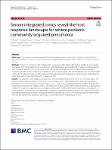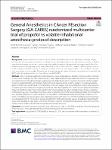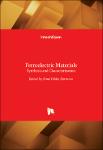Search
Author
- Osman, Ahmed I. (5)
- Daqing, Ma (3)
- Jorgensen, Ed (3)
- Li, Yan (3)
- next >
Subject
- kinh tế (26)
- Economics (12)
- programming (10)
- XRD (10)
- next >
Date issued
- 2020 - 2025 (2128)
- 2010 - 2019 (129)
- 2000 - 2009 (9)
- 1999 - 1999 (1)
Has File(s)
Search Results
Starting from the principle of locality in quantum field theory, which states that an object is influenced directly only by its immediate surroundings, we review some features of the notion of locality arising in physics and mathematics. We encode these in locality relations, given by symmetric binary relations, and locality morphisms, namely maps that factorise on products of pairs in the graph of such locality relations. This factorisation is a key property in the context of renormalisation, as illustrated on the factorisation of an exponential sum on convex cones, discussed at the end of the paper. |
Community-acquired pneumonia (CAP) is the primary cause of death for children under five years of age globally. Hence, it is essential to investigate new early biomarkers and potential mechanisms involved in disease severity. |
Privacy protection in the computer vision field has attracted increasing attention. Generative adversarial network-based methods have been explored for identity anonymization, but they do not take into consideration semantic information of images, which may result in unrealistic or flawed facial results. In this paper, we propose a Semantic-aware De-identification Generative Adversarial Network (SDGAN) model for identity anonymization. To retain the facial expression effectively, we extract the facial semantic image using the edge-aware graph representation network to constraint the position, shape and relationship of generated facial key features. |
The text builds outward from the basic concepts and definitions of the underlying physics, guiding the reader through thermodynamic properties and introducing the subject of gasses. From there, the First and Second Laws of Thermodynamics are explored in some depth.
Each Chapter and Section begins with some introductory text, followed by Examples. It is noted that the Solutions to the Examples seem to be written for students with some familiarity with Engineering Thermodynamics; this appears to be inconsistent with the book’s title, which is Introduction to Engineering Thermodynamics. It is recommended that the Sections be reviewed and edited to provide a sequence of problems of increasing complexity, with all steps delineated, for the training of the students in this field. |
This paper proposes a linear categorical random coefficient model, in which the random coefficients follow parametric categorical distributions. The distributional parameters are identified based on a linear recurrence structure of moments of the random coefficients. A generalized method of moments estimation procedure is proposed, also employed by Peter Schmidt and his coauthors to address heterogeneity in time effects in panel data models. Using Monte Carlo simulations, we find that moments of the random coefficients can be estimated reasonably accurately, but large samples are required for the estimation of the parameters of the underlying categorical distribution. |
The main objective of this article is to study the dynamic transition associated with the activator-substrate system. Two criteria are derived to describe the transition from real eigenvalues or complex eigenvalues and the types of transition. Notably, we get two parameters b1 and b2, which can determine the the types of transitions for the two criteria respectively. The analysis is carried out using dynamic transition theory developed recently by Ma and Wang (Phase transition dynamics, Springer, New York, 2013, Bifurcation Theory and Applications, World Scientific, Singapore, 2005, Stability and Bifurcation of Nonlinear Evolutions Equations, Science Press, Beijing, China, 2007). |
Quantum permutations arise in many aspects of modern “quantum mathematics”. However, the aim of this article is to detach these objects from their context and to give a friendly introduction purely within operator theory. We define quantum permutation matrices as matrices whose entries are operators on Hilbert spaces; they obey certain assumptions generalizing classical permutation matrices. We give a number of examples and we list many open problems. We then put them back in their original context and give an overview of their use in several branches of mathematics, such as quantum groups, quantum information theory, graph theory and free probability theory. |
In this paper, we introduce a proximal point-type of viscosity iterative method with double implicit midpoint rule comprising of a nonexpansive mapping and the resolvents of a monotone operator and a bifunction. Furthermore, we establish that the sequence generated by our proposed algorithm converges strongly to an element in the intersection of the solution sets of monotone inclusion problem, equilibrium problem and fixed point problem for a nonexpansive mapping in complete CAT(0) spaces. In addition, we give a numerical example of our method each in a finite dimensional Euclidean space and a non-Hilbert space setting to show the applicability of our method . Our results complement many recent results in the literature. |
Studies indicate that patients can be “seeded” with their own cancer cells during oncologic surgery and that the immune response to these circulating cancer cells might influence the risk of cancer recurrence. Preliminary data from animal studies and some retrospective analyses suggest that anesthetic technique might affect the immune response during surgery and hence the risk of cancer recurrence. In 2015, experts called for prospective scientific inquiry into whether anesthetic technique used in cancer resection surgeries affects cancer-related outcomes such as recurrence and mortality. Therefore, we designed a pragmatic phase 3 multicenter randomized controlled trial (RCT) called General Anesthetics in Cancer Resectio |
Ferroelectric materials receive great attention from the scientific international community because of the interesting phenomena they exhibit and their multiple applications such as transducers, capacitors, pyroelectric sensors, sonars, random access memories, etc. The demand for ferroelectric materials for technological applications enforced the in-depth research, in addition to the improvement of processing and characterization techniques. This book contains nine chapters and offers the results of several researches covering fabrication, properties, theoretical topics, and phenomena at the nanoscale. |










